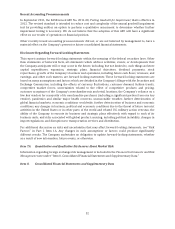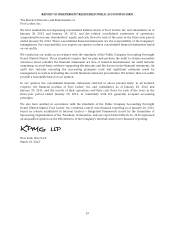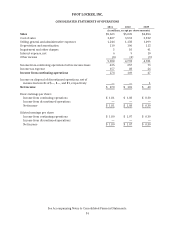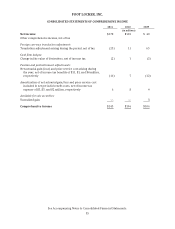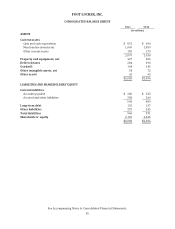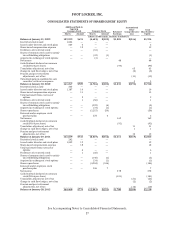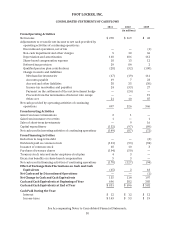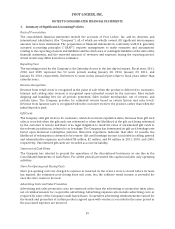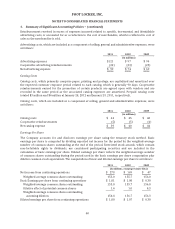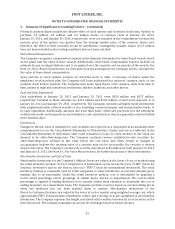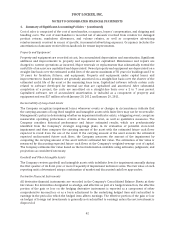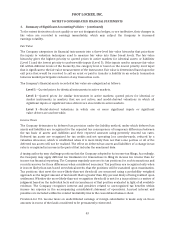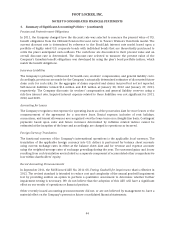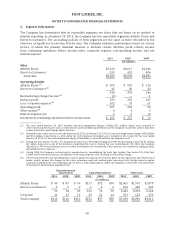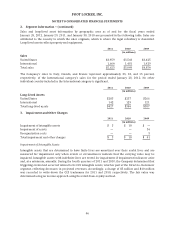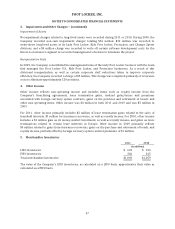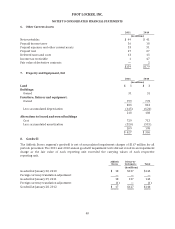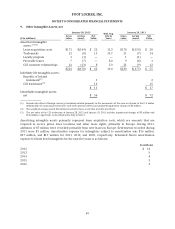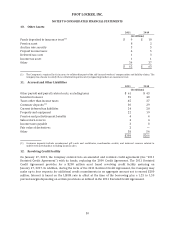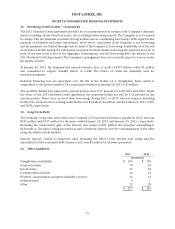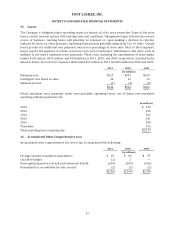Foot Locker 2011 Annual Report Download - page 62
Download and view the complete annual report
Please find page 62 of the 2011 Foot Locker annual report below. You can navigate through the pages in the report by either clicking on the pages listed below, or by using the keyword search tool below to find specific information within the annual report.FOOT LOCKER, INC.
NOTES TO CONSOLIDATED FINANCIAL STATEMENTS
1. Summary of Significant Accounting Policies − (continued)
Cost of sales is comprised of the cost of merchandise, occupancy, buyers’ compensation, and shipping and
handling costs. The cost of merchandise is recorded net of amounts received from vendors for damaged
product returns, markdown allowances, and volume rebates, as well as cooperative advertising
reimbursements received in excess of specific, incremental advertising expenses. Occupancy includes the
amortization of amounts received from landlords for tenant improvements.
Property and Equipment
Property and equipment are recorded at cost, less accumulated depreciation and amortization. Significant
additions and improvements to property and equipment are capitalized. Maintenance and repairs are
charged to current operations as incurred. Major renewals or replacements that substantially extend the
useful life of an asset are capitalized and depreciated. Owned property and equipment are depreciated on a
straight-line basis over the estimated useful lives of the assets: maximum of 50 years for buildings and 3 to
10 years for furniture, fixtures, and equipment. Property and equipment under capital leases and
improvements to leased premises are generally amortized on a straight-line basis over the shorter of the
estimated useful life of the asset or the remaining lease term. Capitalized software reflects certain costs
related to software developed for internal use that are capitalized and amortized. After substantial
completion of a project, the costs are amortized on a straight-line basis overa2to7year period.
Capitalized software, net of accumulated amortization, is included as a component of property and
equipment and was $27 million at both January 28, 2012 and January 29, 2011.
Recoverability of Long-Lived Assets
The Company recognizes impairment losses whenever events or changes in circumstances indicate that
the carrying amounts of long-lived tangible and intangible assets with finite lives may not be recoverable.
Management’s policy in determining whether an impairment indicator exists, a triggering event, comprises
measurable operating performance criteria at the division level, as well as qualitative measures. The
Company considers historical performance and future estimated results, which are predominately
identified from the Company’s strategic long-range plans, in its evaluation of potential store-level
impairment and then compares the carrying amount of the asset with the estimated future cash flows
expected to result from the use of the asset. If the carrying amount of the asset exceeds the estimated
expected undiscounted future cash flows, the Company measures the amount of the impairment by
comparing the carrying amount of the asset with its estimated fair value. The estimation of fair value is
measured by discounting expected future cash flows at the Company’s weighted-average cost of capital.
The Company estimates fair value based on the best information available using estimates, judgments, and
projections as considered necessary.
Goodwill and Other Intangible Assets
The Company reviews goodwill and intangible assets with indefinite lives for impairment annually during
the first quarter of its fiscal year or more frequently if impairment indicators arise. The fair value of each
reporting unit is determined using a combination of market and discounted cash flow approaches.
Derivative Financial Instruments
All derivative financial instruments are recorded in the Company’s Consolidated Balance Sheets at their
fair values. For derivatives designated as a hedge, and effective as part of a hedge transaction, the effective
portion of the gain or loss on the hedging derivative instrument is reported as a component of other
comprehensive income/loss or as a basis adjustment to the underlying hedged item and reclassified to
earnings in the period in which the hedged item affects earnings. The effective portion of the gain or loss
on hedges of foreign net investments is generally not reclassified to earnings unless the net investment is
disposed of.
42


